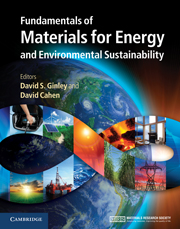Book contents
- Frontmatter
- Contents
- Contributors
- Preface
- Acknowledgments
- Part 1 Energy and the environment: the global landscape
- 1 A primer on climate change
- 2 The global energy landscape and energy security
- 3 Sustainability and energy conversions
- 4 Energy cost of materials: materials for thin-film photovoltaics as an example
- 5 Economics of materials
- 6 Global energy flows
- 7 Global materials flows
- 8 Carbon dioxide capture and sequestration
- Part 2 Nonrenewable energy sources
- Part 3 Renewable energy sources
- Part 4 Transportation
- Part 5 Energy efficiency
- Part 6 Energy storage, high-penetration renewables, and grid stabilization
- Summary
- Appendix A Thermodynamics
- Appendix B Electrochemistry
- Appendix C Units
- Index
- References
2 - The global energy landscape and energy security
from Part 1 - Energy and the environment: the global landscape
Published online by Cambridge University Press: 05 June 2012
- Frontmatter
- Contents
- Contributors
- Preface
- Acknowledgments
- Part 1 Energy and the environment: the global landscape
- 1 A primer on climate change
- 2 The global energy landscape and energy security
- 3 Sustainability and energy conversions
- 4 Energy cost of materials: materials for thin-film photovoltaics as an example
- 5 Economics of materials
- 6 Global energy flows
- 7 Global materials flows
- 8 Carbon dioxide capture and sequestration
- Part 2 Nonrenewable energy sources
- Part 3 Renewable energy sources
- Part 4 Transportation
- Part 5 Energy efficiency
- Part 6 Energy storage, high-penetration renewables, and grid stabilization
- Summary
- Appendix A Thermodynamics
- Appendix B Electrochemistry
- Appendix C Units
- Index
- References
Summary
Focus
The global energy landscape encompasses the distribution of energy resources, as well as the related aspects of energy production, storage, transmission, use, and efficiency. In addition, energy use has been correlated with economic development. Together, these attributes define the context within which countries strive to satisfy their energy demands, in terms of both economic productivity and quality of life. With the current rapid increase in demand for energy, the question of how countries will provide their populations with access to a clean and affordable energy supply in an environmentally sustainable manner has emerged as a grand challenge for today's society.
Synopsis
This chapter summarizes the global energy resources and their availability, economic viability, and environmental consequences. Although these topics are discussed with respect to individual fuels and technologies in greater detail in other chapters of this book, they are examined here in a broader sense relating to the overall global energy landscape.
- Type
- Chapter
- Information
- Publisher: Cambridge University PressPrint publication year: 2011



